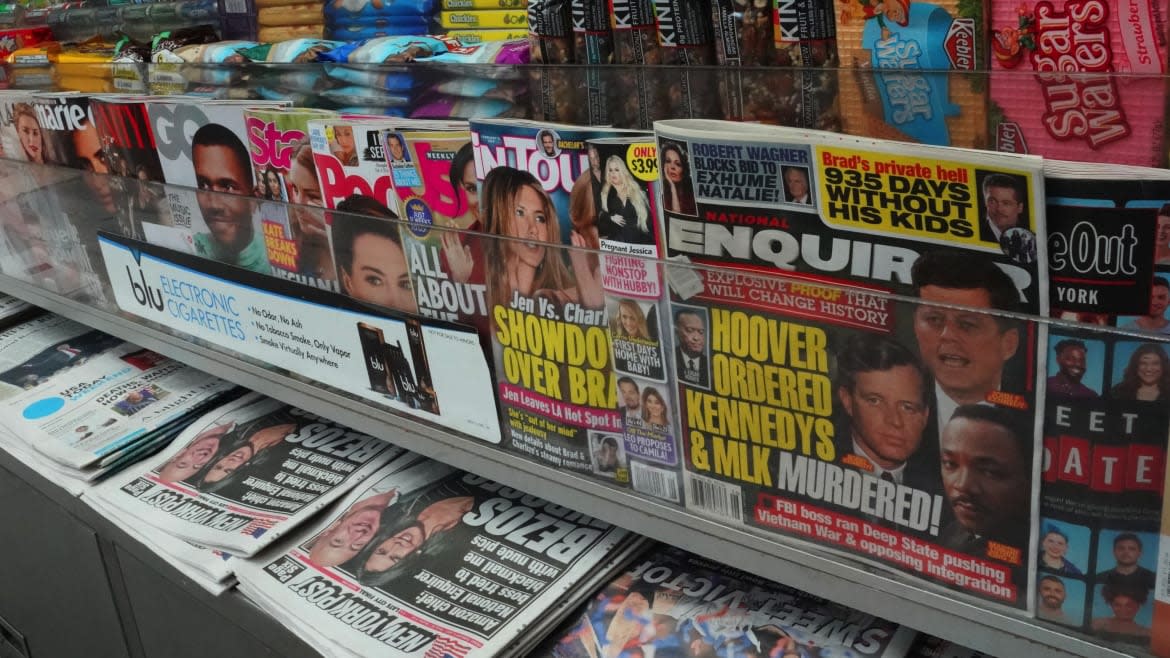The Celebrity Tabloids Enter Bizarro-World Amid Coronavirus

In early 2002, as Us Weekly Magazine transitioned from a monthly magazine to a photo-heavy weekly, the editors gathered for their daily meeting, eyed all the images fresh from the wire, and zeroed in on a picture of Drew Barrymore picking up a coin. “Look at Drew Barrymore picking up a penny,” the new top editor Bonnie Fuller said, according to former Us reporter Kate Lee. “It’s like, stars, they’re just like us.” When the next issue went to print, it featured a new kind of photo montage, one that highlighted—not movie premieres or nights on the town—but pictures of actors leaving fast food franchises. “Russell Crowe: Trying desperately to crack the Colonel’s recipe at KFC in New York,” the text bubble read. “David Hasselhoff: Devouring a hot dog—with another one at his feet.”
The new section, “Stars, They’re Just Like Us!,” changed the nature of celebrity imagery in America’s pop-cultural diet. It created a new visual vocabulary for the entertainment industry, a crucial boon to the notion that celebrities, despite their mansions and lifestyle brands, nevertheless led somewhat normal lives. Where paparazzi once scouted for exclusives and high-end events, they could now sell snapshots of the mundane. Stars, they walk their dogs! They take public transportation! They love amusement parks!
We Asked the Church of Scientology How They’re Combatting Coronavirus. This Is Their Wild Response.
The Coronavirus Pandemic Proves, Once Again, That Celebrities Are Not Just Like Us
If that logic held, the genre might be flourishing now, 18 years later, as the COVID-19 outbreak forces both actors and everyone else to perform certain shared behaviors—cover their faces, stock up on toilet paper, wash their hands with Monk-like intensity. Instead, the section has entered a state of suspended animation. There is no mention of the novel coronavirus on Us Weekly’s formerly active feed—the closest they come is a Feb. 26 photo of actress Zoey Deutch in a mask, but without context (“They Worry About Germs!,” the caption reads). The most recent photo is nearly a month old. In it, A Quiet Place Part II’s Cillian Murphy tosses a crumpled piece of paper into an NYC garbage bin, looking as solemn and forlorn as the section feels: “They put trash in its place!”
The supermarket tabloid is in uncertain terrain. As the global pandemic rages, most nonessential industries have found themselves in a kind of paralysis. Sporting events are suspended. Live shows are cancelled. Small businesses are closing at a devastating rate. Glossy grocery store magazines, which once seemed like the roaches that could withstand nuclear winter, have seen their subjects and audience wiped out in one fell swoop. Stars decamped to their bunkers. Supermarkets became games of spatial Tetris, as shoppers maintained their 6-foot distance. Leisure reading in line went by the wayside. Just last week, a former employee of American Media Inc., the tabloid conglomerate that owns Star, OK!, In Touch, Closer, Life & Style, Examiner, Globe, US Weekly!, and Radar Online, told The Daily Beast that the company was “on a ventilator.”
And yet, from looking at their magazines, it is not obvious that both the tabloid industry and the country at large are under siege. The more substantial entertainment publications—E! News, People, or TMZ—have published the odd pap photo of stars practicing social distancing, wearing masks in the park or taking exceedingly slow walks. But while the virus dominates mainstream media, in much of the tabloid landscape, it feels like an afterthought—mentioned in the mix of legal feuds and pregnancy updates, or at times, not at all.
Part of the problem is that social distancing has changed the paparazzi ecosystem. The normal stops for celebrity sightings—production sets, airports, red carpet events—have been all but abandoned. “On any given day there’s normally upwards of 30-plus productions shooting around town, and 90 percent of the time I’d just be on one of those,” a pap photographer told the Los Angeles Times. “When those started shutting down, that put me back out on the streets like when I first started this job, camping out in front of celebrities’ homes.”
What few sightings they find, some photographers have worried, might seem too much like us—that is, quarantined, doing the same thing day in and day out, destined to be redundant. Others have argued that, despite celebrity claims to the contrary, the crisis has only clarified the ways stars are, in fact, not like us in the least.
For decades, gossip magazines operated as their own kind of narrative engine. With secret sources and blurry shots, they could weave storylines of feuds and tragedies, turning divorces into battlegrounds, weight losses into epic journeys, grocery runs into human-interest interludes. They could paint public figures as heroes, villains, or relatable average Joes. At times, those stories could serve a quasi-psychological function. “Gossip has always allowed us to speak the otherwise unspeakable,” BuzzFeed’s Anne Helen Petersen wrote in a piece about the industry’s decline, “working through understandings of sex and femininity and sexuality in a space ‘distant’ from our own.”
Petersen was arguing that social media, which allowed celebrities unprecedented control over their public image, had kneecapped the gossip industry’s grasp over pop-cultural history. But in a sense, the tabloids’ relative silence on what may be the greatest crisis of a generation does tell a story—of a culture on pause, or the brink of collapse.
Got a tip? Send it to The Daily Beast here
Get our top stories in your inbox every day. Sign up now!
Daily Beast Membership: Beast Inside goes deeper on the stories that matter to you. Learn more.

 Yahoo News
Yahoo News 
